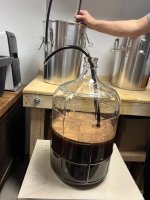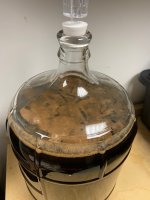BoitAHL
Well-Known Member
Hello,
I am making a 3rd attempt this weekend at brewing an Imprint Beer Co. Black Forest Cake Stout Clone. Here is a link to my previous post.
High ABV Stout Clone
My 2 previous attempts had a couple issues. Although the beer turned out very tasty, it got nowhere near the expected FG and was a bit sweet. Also, even though I was using a blowoff tube both fermentations blew (see same post link). I have a couple ideas to run by you.
1. For the FG issue I have purchased an O2 Aeration Kit. Have not used one previously. Hoping better oxidation will help the yeast. Also, I am planning to aerate and pitch half the yeast on brew day then aerate and pitch the 2nd half 24 hours later. Concerning O2 aeration, I have read many opinions on how long to aerate and need advice.
2. For the blowout issue I am planning to ferment in two separate 6-gallon fermenters at 2.5 gallons of wort each. I cannot control room temperature much but with the heat off it will be in the low to mid 60's. Hoping this will prevent the blowout.
Any advice or alternate ideas you could give will be greatly appreciated.
Thanks.
Steve
I am making a 3rd attempt this weekend at brewing an Imprint Beer Co. Black Forest Cake Stout Clone. Here is a link to my previous post.
High ABV Stout Clone
My 2 previous attempts had a couple issues. Although the beer turned out very tasty, it got nowhere near the expected FG and was a bit sweet. Also, even though I was using a blowoff tube both fermentations blew (see same post link). I have a couple ideas to run by you.
1. For the FG issue I have purchased an O2 Aeration Kit. Have not used one previously. Hoping better oxidation will help the yeast. Also, I am planning to aerate and pitch half the yeast on brew day then aerate and pitch the 2nd half 24 hours later. Concerning O2 aeration, I have read many opinions on how long to aerate and need advice.
2. For the blowout issue I am planning to ferment in two separate 6-gallon fermenters at 2.5 gallons of wort each. I cannot control room temperature much but with the heat off it will be in the low to mid 60's. Hoping this will prevent the blowout.
Any advice or alternate ideas you could give will be greatly appreciated.
Thanks.
Steve






